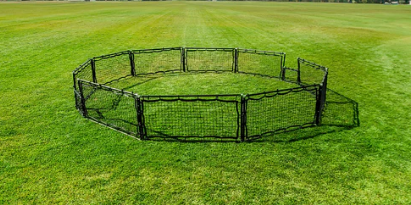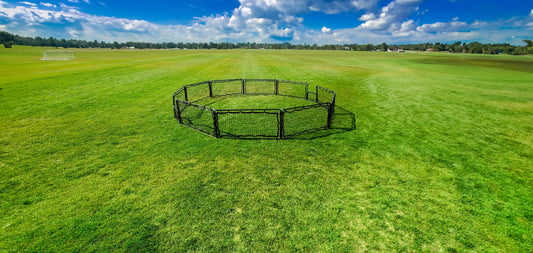This article is perfect for the beginner looking to learn Pickleball. This article will teach you everything you need to know, from Pickleball rules to choosing the right grip on your Pickleball paddle.
What Is Pickleball?
Pickleball is a unique combination of tennis, ping pong, and badminton, creating a fast-paced, fun game for all ages. The game started in the United States in 1965 by three fathers looking to find a more entertaining game for their young kids. Since its humble origins, Pickleball has become one of the most popular games across the nation and has spread its wings and crossed the sea into European countries.
When the three fathers first created the game, they used a lowered badminton net, ping pong paddles, and a perforated plastic ball. They volleyed the ball back and forth over the net and began adding rules that paralleled badminton rules. In 1972, the friends decided that the game was fun enough to make official.
By 1976, they were hosting tournaments where they invited tennis players to participate and learn the game. From there, the game sparked into a popular sport played everywhere in the United States-and to think it all started because kids were bored. 
How Do You Set Up Pickleball?
To play the game, you will need a pickleball court.
Traditionally, a pickleball court is the same size as a badminton court, which is 20 by 44 feet. Each half of the court is 22 feet, with a 7 feet no-volley space directly next to the net. The free-to-volley area is 15 feet. When playing doubles, the court is cut in half so that each player has 10 feet on their side. Proper net height height should be 36 inches on the sides and 34 inches (due to sagging) in the center.
In terms of equipment, players will need a pickleball paddle and a pickleball, similar to a whiffle ball. Players can choose between various paddles and pickle balls to improve their play and strengthen their strategies. However, beginners will want to stick to the basics before diving into the thousands of variations.
To play, players will want to dress comfortably, as if going for a light jog or playing a game of tennis. There's no official pickleball attire, so dress in whatever you feel comfortable in. Avoid wearing large, bulky clothes that could limit your movement.
What Are the Rules of Pickleball?
Official Pickleball's rules are still fairly similar to its origins and are similar to badminton rules. Here are the basic rules for playing Pickleball:
Serving the Ball
Serving the ball is fairly easy. Here's everything you need to know.
- The server serves the ball underhand. Their arm must be moving in an upward arch to hit the ball, and players must hit all paddleball serving shots below the waist.
- Players can also "drop serve" the ball. In a drop serve, the player drops the ball from a higher height and hits it as it arches towards their paddle.
- Players serve from outside the court.
- When the player hits the ball, the ball must go to the diagonal court.
- If the players mess up their serve, the ball goes to the other team. Only one serve is allowed-no re-dos.

The Volley
Players try to keep up a constant volley back and forth between the two sides of the court. In most games, players play doubles.
- When hitting the ball directly after the serve, the opposing team must let the ball bounce before volleying the ball back across the court.
- Players can "volley" a ball, which means they hit the ball without the ball bouncing (excluding the play directly after the serve). Players cannot volley when inside the no-volley zone.
- The ball must bounce once on both sides of the court before either team is allowed to volley.
- The ball can always bounce once on a side of the court. If the ball bounces more than once, it's considered a fault.

Scoring a Point
Scoring points in Pickleball is simple and is similar to badminton. Here's all you need to know about scoring points in Pickleball.
- Players can only score points on their serve. They gain the serve when the other team makes an error and keep the serve until they make an error.
- Players "fault" by disobeying the double-bounce rule and volleying too soon, letting the ball bounce more than once, hitting the ball into the net, or hitting the ball out of bounds.
- The first team to 11 points wins; however, teams must win by two points.
Do You Need a Pickleball Net?
When playing with a club or other official group, you should invest in a pickleball net or practice on a pickleball court. An official pickleball net is 20 feet across and 36 inches tall. If playing just for fun, you could substitute a tennis net or badminton net (with some modifications).
A tennis net is three feet tall (36 inches) at the middle and three feet and six inches (42 inches) at the poles. The net's length is 42 feet across since the tennis court is much larger than a pickleball court. A tennis doubles court is 36 feet wide and 78 feet long (slightly smaller when playing singles).
Although the height of a tennis net and the height of a pickleball net are fairly similar, it would be difficult to set up the net since the tennis net's length is nearly twice as long as the pickleball net. However, with no other options, it's doable.
A badminton net is five feet and one inch tall at the poles and five feet in the center. It also spans about 20 feet across, making it similar to a pickleball net. When Pickleball was first created, the creators used a lowered badminton net to play the game. If players have no other options and only have access to a badminton net, they could lower the net and have a passable pickleball net.
If choosing between a tennis net and a badminton net, the badminton net would be the better option. However, it would be a lot easier to just use a pickleball net on a pickleball court.
Where Can You Buy a Pickleball Net?
Regulation size pickleball nets are easy to find. You can find a portable pickleball net with a carrying case at Walmart, Target, or any other store equipped with general sports equipment. An inexpensive Pickleball net will cost less than $50, while more expensive nets could cost over $100. You can also buy professional equipment from various online markets such as Pickleball Central.
The paddles are also easy to find and inexpensive, as long as you're a beginner looking for basic paddle designs. At a sports store, you can find pickleball paddles for just over $30. Pickle balls typically cost no more than $10 for two or three in a set.
Knowing what to look for in a Pickleball net system is just as important as knowing where to buy it. In the next section, we'll show you the most important Pickleball net and paddle features. 
What Should You Look For in a Pickleball Set?
When shopping for a Pickleball set, make sure you're meeting standard game requirements. Here's everything you need to know about choosing a net, paddle, and ball.
Pickleball Nets
Pickleball nets must be made of a netted material that balls can't pass through. The material itself doesn't matter as long as it meets the standard requirements.
The net must be 21 feet and nine inches in length and a net height of 36 inches (at the sides) and 34 inches (in the middle). If using a permanent net, you will also need a center strap that ensures that the middle of the net is 34 inches. Additionally, the posts can't be over three inches in diameter and need to be 22 inches from one post to the other.
When using a portable net, find one that is a regulation size that feels good to you. Having a carrying bag for your net system will make it easier to bring from game to game. Another point to look for is a net that has a high net tension. Looser nets might drop the height of the net, making it fall below a typical regulation size net.
You may also consider whether you want a net edge, which defines the net to make it easier to aim precise shots. Having a net stand with a metal frame instead of plastic oval tubing will increase net durability but decrease portability. Using a net with a carbon fiber net post will make sure the net is still light while not
sacrificing the net tension or easy transport.
Pickleball Paddles
If you're a casual player, just look for a pickleball paddle that fits in your hand and feels comfortable to swing upward. If you're looking to begin playing competitively, there are a few additional things to look for, including weight, grip, and shape.
Find Your Weight Category
First, decide which weight you feel most comfortable playing with. Paddles range between 6 ounces for a lightweight paddle and 12 ounces for a heavyweight paddle, with several weight categories in between.
Lightweight paddles include any paddle that is under 7.2 ounces. They make ball control easier and put less stress on the elbow and shoulder. Players using lightweight paddles can play for longer without feeling the ache growing in their shoulder and wrist.
Lightweight paddles have reduced power, and players will have to swing harder to move the ball faster. Having less power also means that it's harder to hit the ball further, limiting your range.
On the other hand, heavy paddles (over 8.2 ounces) have more power and require less effort to hit the ball across the court. Players who use heavy paddles can hit the ball deep into the court with less effort.
However, because the paddle is heavier, it will put more stress on the elbow, wrist, and shoulder. Players using heavy paddles can't play for as long because there is an injury risk. Heavy paddles also have less control because of the effort weight in the swing.
Before deciding on the right paddle weight, use a mid-weight paddle. These paddles are between 7.2 and 8.2 ounces and are a healthy balance between the pros and cons of both the lightweight paddle and the heavy paddle. While using the mid-weight paddle, you'll establish a playing style and be able to decide whether to lean towards the lighter or heavier paddle for long-term playing. 
Find Your Grip Category
Everyone has a different grip size. Playing with a too small grip or too large will change your swing, making it harder to hit the ball with any accuracy. However, there are advantages to picking one grip size over another.
A small grip increases your accuracy and makes it easier to adjust the paddle in small movements. Players with smaller grips have an easier time spinning the ball or adding additional power to a serve or hit.
A larger grip will ease the strain on the wrist while increasing stroke stability. While it has some benefits, a grip that is too large for your hand will put a strain on the elbow, increasing your risk of injury. You want your paddle to fit comfortably in your hand.
You can always increase the gri[ of your hand by adding tape or overgrip to the paddle's handle. You can't decrease the grip size of a paddle, so (if in doubt) buy a paddle that has a smaller grip and add to it until you feel comfortable that it's the right size. 
Find the Right Shape and Material
Players can choose between wood, graphite, and composite paddles. Wood is the cheapest material but also the heaviest, meaning that it has limited professional options. Graphite paddles are the most expensive but are light and powerful. The composite combines wood and graphite and comes in a wide range of weights and prices.
Most beginners choose wood paddles because they are inexpensive, while professionals tend to choose graphite or composite, depending on their preferences and styles.
In terms of shape, players can choose between edged and edgeless paddles, wide-body paddles, elongated paddles, and oversized paddles. Beginners won't need to worry too much about the paddle's shape and can use a standard paddle. Experts and serious players can choose different shaped paddles to maximize their playstyle.
An edgeless paddle increases the paddle's playing surface, though these paddles are susceptible to chips and damage. Wide-body paddles are around 8 inches in width and 15 inches in length. Elongated paddles are 17 inches long, which is the maximum paddle length allowed in a game. It extends the player's reach and acts as an extension of the player's arm. Finally, oversized paddles have wider bodies and reach the maximum handle restrictions. 
Pickle Balls
There's little room for debate with the ball used in Pickleball. Official balls are plastic and are three inches in diameter. They typically weigh between .08 ounces and 1.02 ounces. Players don't have much choice between the size or shape of the ball. Players can choose the colors as long as all the balls are the same color.
Optional Equipment
For those who fall in love with Pickleball, consider this short list of optional equipment that could improve your gameplay.
- Ball Holder:
A ball holder pairs perfectly with a portable net system, making it easy for the pickleball player to carry their equipment from one net system to the next.
- Nylon Bag:
When traveling to a pickleball tournament, having a nylon bag will keep your paddles and balls safe.
- Vinyl Headband:
Although not a vital part of a traditional pickleball game, having a headband will keep the sweat from your eyes while playing intense Pickleball games. 
Playing Your Best Game
Once you have your net and paddle, you can begin learning the strategy behind the game. Overall, practice is the most important thing you can do to improve your game. Practice casually with friends and learn a playstyle that you feel comfortable with.
Here are three Pickleball strategies you should practice that could help you win your games:
1. Move to the Net
One of the best strategies is moving to the net. The team that utilizes the net is usually the winning team. If you’re up by the net, your hits will go deeper, forcing the opposing team to take a step back and making them play defense. 
2. Focus Your Serve
Don’t try to ace your serve every time. Instead, focus on getting the serves perfect. Missing your serve is an easy way to hand over points to the opposite team. During practice, drill your serve until a perfect serve is second nature to your. 
3. Work With Your Partner
Most importantly, practice with your partner. Every chance you get, build communication with your partner. Simple phrases like, “Mine,” or “No!” can be the difference in a game. Additionally, keep an eye on the space between you and your partner. Too much space leaves an opening for the opposing team.
In the end, practice really does make perfect. Practice with players who are better than you and aim to learn their strategies for the game. Focusing on your game and focusing on your love of the game will help improve your strategy.
Other Fun Games
If you're looking for some other fun games, check out our versions of 9 square and Gaga Ball.







